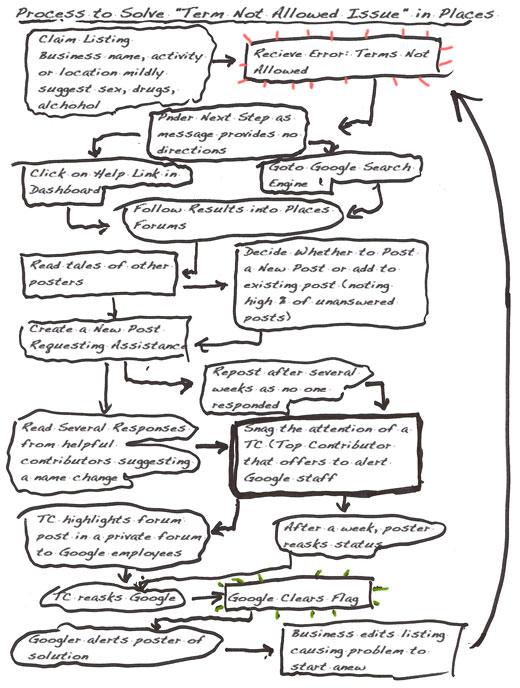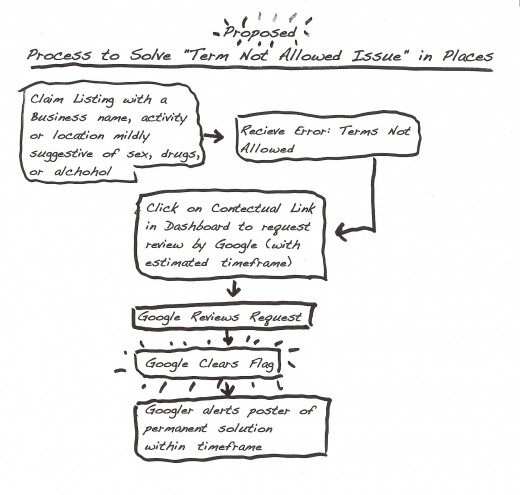Ethan Russell, a Product Manager on Google’s local search team, recently
posted some comments on my post:
Google Customer Service: Up Against the Algo. He noted that sometime this quarter, Google will be rolling out a service solution to the
long standing problem of two listings merging. It doesn’t appear that mergings will cease but rather that, once reported, they will be fixed in a reasonable and predictable timeframe.
Good news for all. Here are his comments and replies to my subsequent email queries:
Ethan Russel: Merged listings are a very frustrating problem — one that we’re working hard to fix. The best thing to do is to click the Report a Problem link on the listing in Google Maps, and choose “Some photos, reviews, or details belong to a different place.” We’re aware that it can currently take quite a while for these problems to be resolved. It’s painful, and it’s one of our top priorities to make this process smoother and faster.
As for some of the advice discussed in this thread, nuking the business listing is at best a temporary fix. As Mike points out, unless the data has changed, the algorithms will eventually make the same decision. Also, providing reviews for your own business is against our policy, even if they have been copied from reviews posted by your customers. I’ll make sure that these points are clarified with our Tags reps.
MB: You noted: We’re aware that it can currently take quite a while for these problems to be resolved. What is the timeframe someone can expect if they follow the procedure you outline?
Ethan Russel: After implementing improvements under development this quarter, we hope to be in the range of 21 days from time of report to time of correction.
MB: You say “under development” this quarter. Does that mean that if the stars are propitious it will be started this quarter or finished this quarter?
Ethan Russel: The work is already in progress, and we hope to finish this quarter.
***
Merging, an artifact of Google’s duplicate removal process is the “flip side” of the duplicate listing issue. If Google dials up the deduping, the mergings go up and if they dial it down the existence of dupes in the index increases.
Having a Google provided service solution to the merging problem is not an alternative to the best practice as far as minimizing the chances of a listing merging in the first place. The problems leading to mergings revolve around confusion in the NAP (name address and phone) between two distinct listings causing two clusters to become one. Here is a check list to prevent or possibly cure mergings while we are waiting for Google’s solution and to prevent them in the future.
1)Be sure that your business name is short and not keyword spammy. The longer it is and the more similar it is to other spammy business titles the greater the chance of a merge
2)Be sure that your phone number is unique to your business. If your number was previously used by a similar and/or nearby business the chances of a merge go up immeasurably.
3)Be sure that your address is a unique reflection of your actual location.
4)Reinforce the name, address and phone number by widespread dissemination of the basic business NAP throughout the local ecosystem.
5)Carefully position your business on the Map when you edit your business in Places.
6)Be sure that you provide reinforcing geo signals to Google via a KML file, geo-sitemap, hCard, geo-tagged photos, myMap references. Confirm that the geo info provided in all these geo-references is accurate to the specific lat-long minute and second.
Remember that Google’s algo is just an algo and if you nuke a listing without changing anything of the underlying data and signals that the algo looks at, the algo is likely to merge the two listings again.
I am hopeful that Google’s customer service solution might put in place some override to keep it from happening again but there is also the danger that citations, reviews and other data might be wrongly associated with the other listing so doing the above is still a good idea.

